Understanding Qualcomm's Snapdragon 810: Performance Preview
by Joshua Ho & Andrei Frumusanu on February 12, 2015 9:00 AM EST- Posted in
- SoCs
- Qualcomm
- Mobile
- Gobi
- Snapdragon 810
GPU Performance
Last but certainly not least, we have GPU performance. As we mentioned earlier, the Snapdragon 810 introduces Qualcomm's Adreno 430, the latest member of the Adreno 400 GPU family. Qualcomm's own performance estimates call for a 30% increase over Adreno 420, with a final GPU clock of 600MHz being identical to the Snapdragon 805's (Adreno 420) own GPU clock speed.
From an architectural standpoint Adreno continues to be something of a black box for us. Other than being a modern OpenGL ES 3.1/AEP design, we don't know too much about how the GPU is laid out, and Qualcomm's current legal battle with NVIDIA likely not helping matters. In any case, Qualcomm has indicated that Adreno 430 is not just a simple extension of Adreno 420, so we may be looking at an architectural change such as wider shader blocks.
For today's benchmarks, as we mentioned before we only had a limited amount of time with the Snapdragon 810 and had issues with BaseMark X. We've had to pare down our GPU benchmarks to just 3DMark 1.2 and GFXBench 3.0. Once we get final hardware in, we will be able to run a wider array of graphics benchmarks on Snapdragon 810.
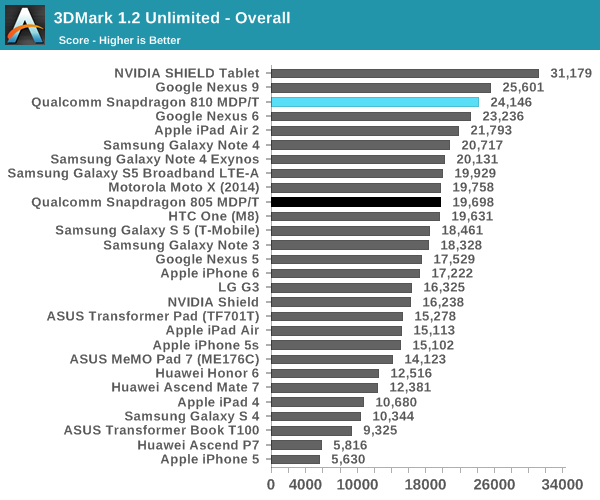
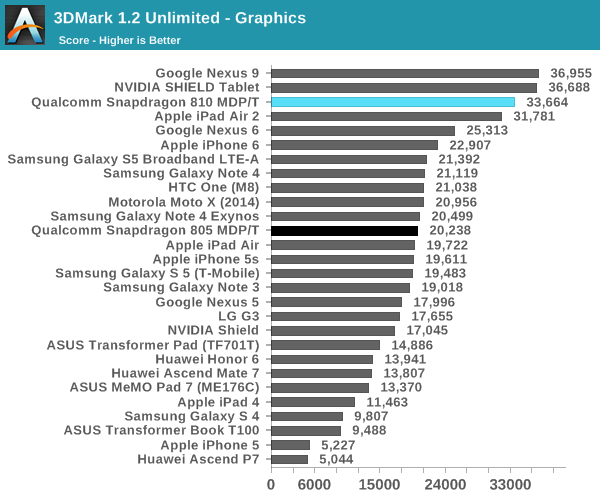
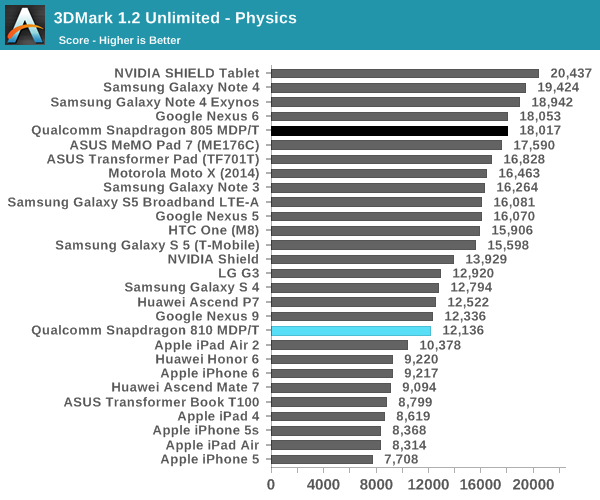
Starting off with 3DMark, compared to the Snapdragon 805 reference platform the actual graphics performance advantage is even greater than 30%, coming in at closer to 65%. However since drivers play a big role in this, a more recent 805 platform like the Nexus 6 may be a better comparison point, in which case the gains are 33%, just a hair over Qualcomm's own baseline performance estimate. We also find that Snapdragon 810 oddly struggles at physics performance here, underperforming Snapdragon 805 devices, something the Exynos 5433 didn't have trouble with. As a result overall performance is only slightly improved over the Nexus 6.
Continuing with GFXBench, we look at more pure GPU loads. One has to take note that the MDP/T employs a 4K screen resolution, and the on-screen results will likely suffer from that.

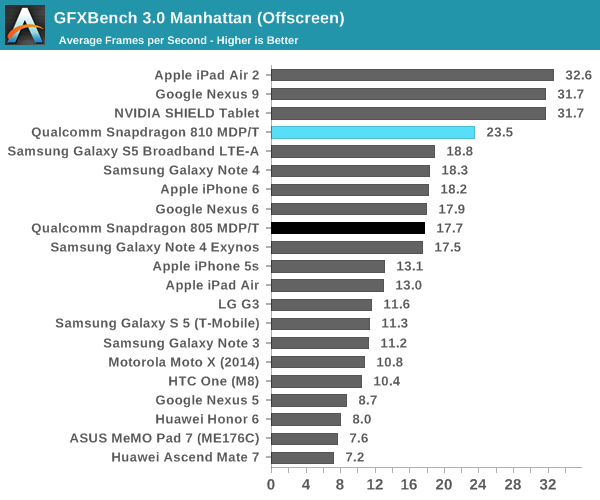
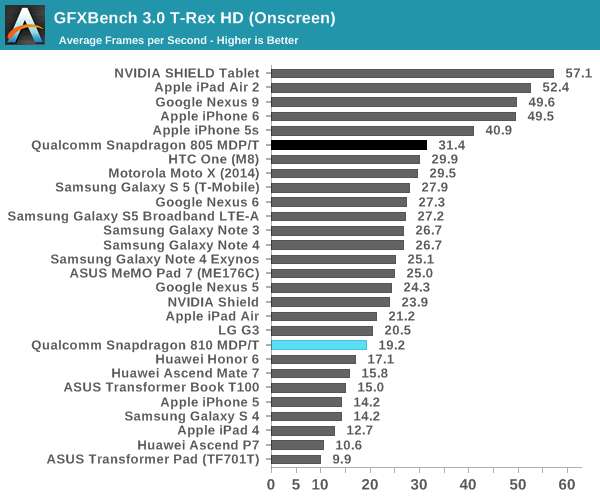
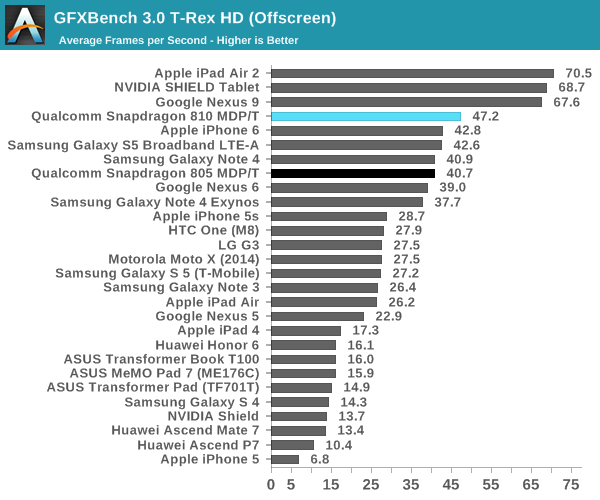
Under GFXBench 3.0's full rendering tests of Manhattan and T-Rex, the Snapdragon 810 continues to show considerable performance gains over the Snapdragon 805. Ignoring the onscreen results for now since the Snapdragon 810 reference platform runs at such a high resolution, offscreen results show the 810 outperforming the 805 by 33% in Manhattan and 16% in T-Rex. The former is again well in-line with Qualcomm's performance estimate, wile the older T-Rex benchmark doesn't show the same gains, possibly indicating that Adreno 430's biggest gains are going to come from shader-bound scenarios.
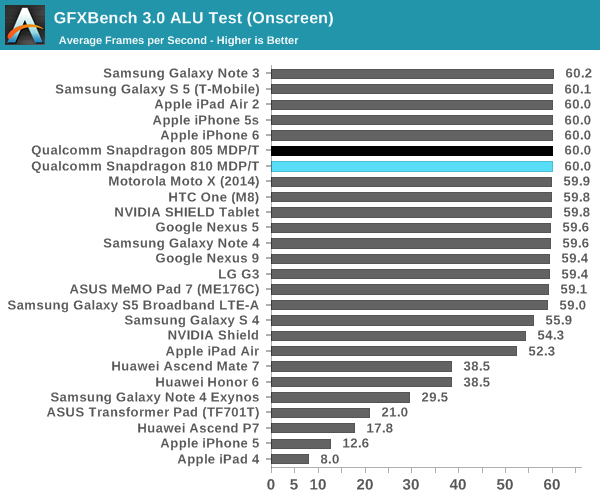
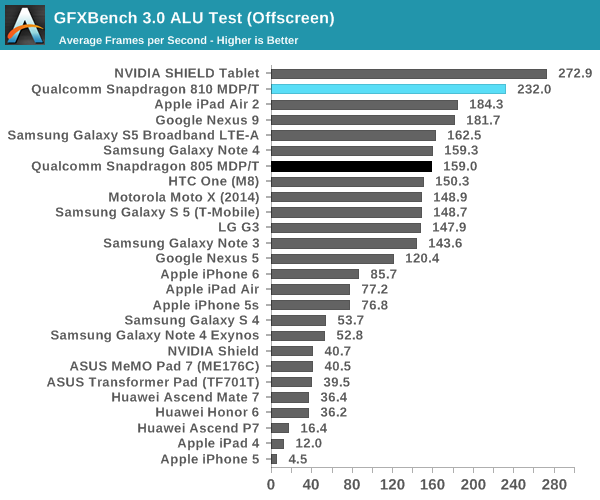

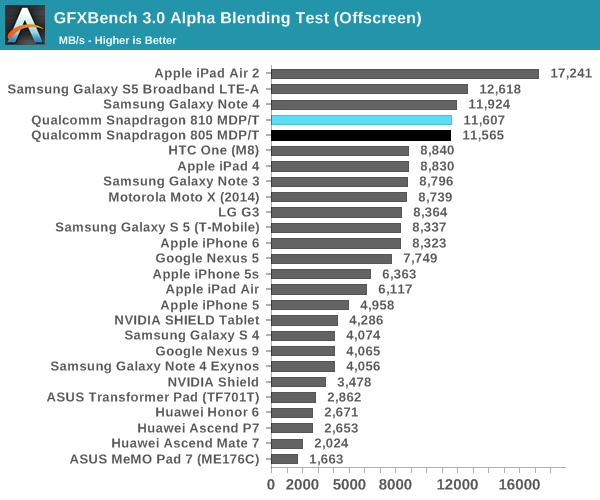
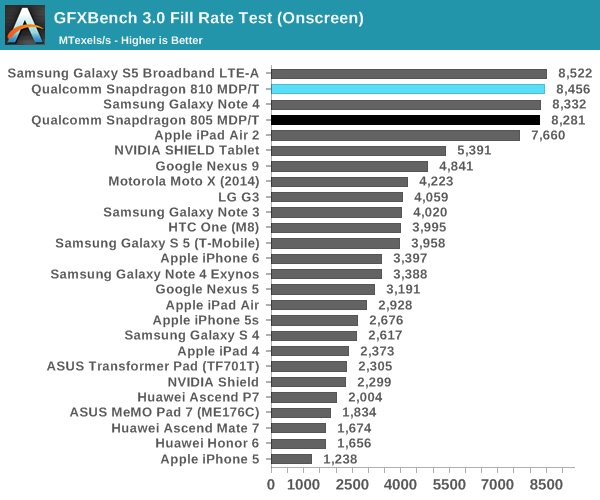
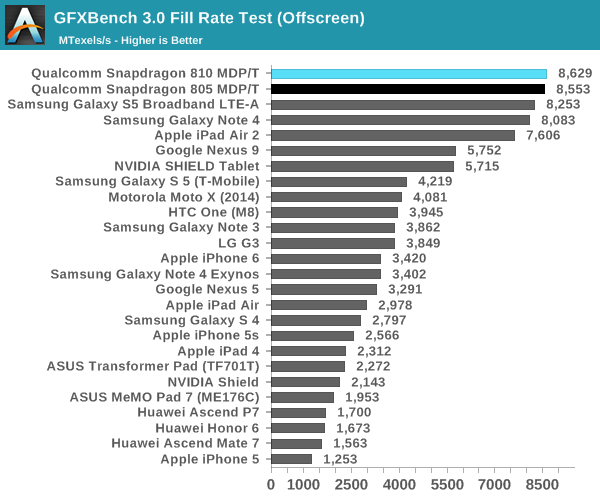
Meanwhile GFXBench's synthetic tests continue to put Adreno 430 and the Snapdragon 810 in a good light. ALU performance in particular is showing very large gains - 46% better than the Snapdragon 805 and Adreno 420 - while our blending and fillrate tests show almost no gain over Snapdragon 805. This adds further credence to our theory that Qualcomm has widened or otherwise improved Adreno's shader blocks for 430, as other elements of the GPU are not showing significant performance changes.
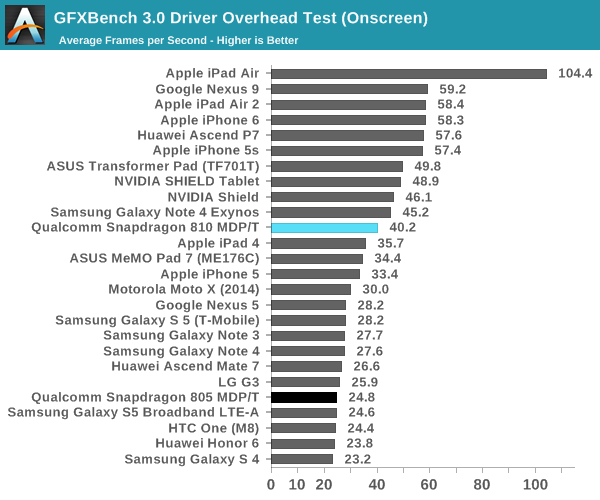
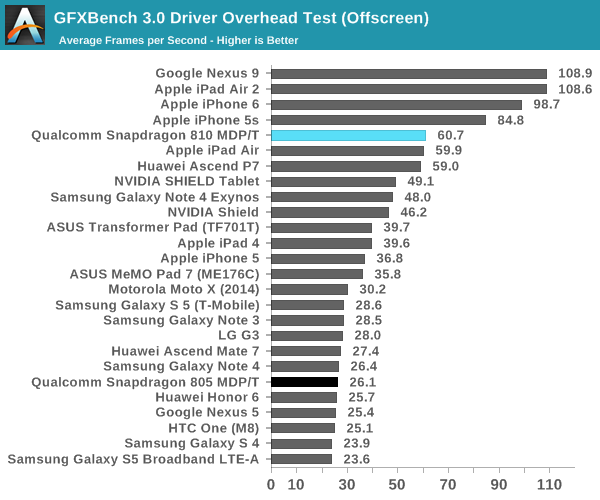
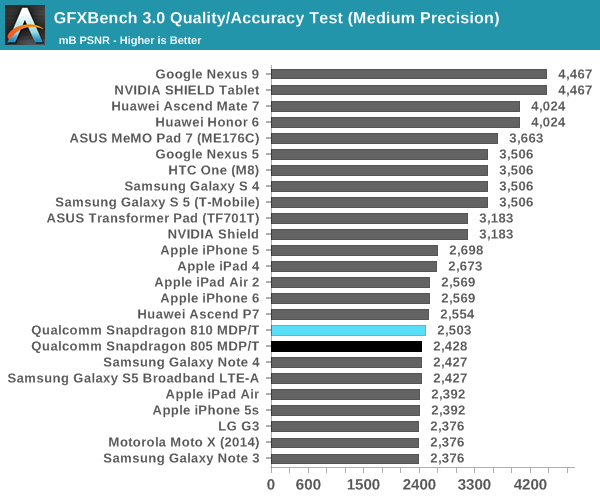

Finally, GFXBench's driver overhead and accuracy tests are more or less what we would expect for Snapdragon 810. In the case of driver overhead, a combination of newer drivers and a much faster CPU have reduced the CPU cost of driver overhead. Meanwhile with the underlying GPU architecture being unchanged, there are no material changes to quality/accuracy.
Overall then the performance gains for the Adreno 430 and Snapdragon 810 seem to be almost exclusively focused on shader performance, but in those cases where rendering workloads are shader bound, Qualcomm's 30% estimate is on the mark. Real-word performance gains meanwhile are going to depend on the nature of the workload; games and applications that are similarly shader-bound should see good performance gains, while anything that's bottlenecked by pixel throughput, texturing, or front-end performance will see much smaller gains. Thankfully for Qualcomm most high-end workloads are indeed shader bound, and this is especially the case when pushing high resolutions, as Qualcomm is trying to do with their 4K initiative for Snapdragon 810. However in the case of 4K, while Adreno 430 offers improved performance it's still slow enough that it's going to struggle to render any kind of decently complex content at that resolution.
As for Adreno 430 versus the competition, Qualcomm has narrowed much of the gap between themselves and NVIDIA/Apple, but they haven't closed it. Apple's Imagination GX6850 and NVIDIA's K1 GPUs continue to hold a performance advantage, particularly in GFXBench's Manhattan and T-Rex full rendering tests. Both Apple and NVIDIA invested significant die space in graphics, and while we don't know how much Qualcomm has invested in Adreno 430 with Snapdragon 810, it's safe to say right now that they would need to invest even more if they want to beat the graphics performance of NVIDIA and Apple's tablet SoCs.










119 Comments
View All Comments
jerrylzy - Friday, February 13, 2015 - link
"Yes, but not this chip. It's going to be Qualcomm's main chip in 2015, it's still getting beaten by year old tech."Please specify what "year old tech" is. The first mobile A57 implementation is Exynos 5433, which is by no means a "year old tech." Also, Snapdragon 810 uses a newer revision r1p1. I cannot see your point here.
"Nevertheless, GPU power matters. This SoC will struggle with 4K and its supposed to be the high-end. Disappointing."
If excluding Apple and NVIDIA, Adreno 430 has the highest GPU power in mobile space. It also has much higher power efficiency compared to ARM Mali-T760 implementations. Adreno 430 may not be competent enough in tablet space, but it is one of the best smartphone GPU available right now.
jerrylzy - Friday, February 13, 2015 - link
I also doubt whether 4K display will appear any time soon on 5.5" or smaller phones.mkozakewich - Friday, February 13, 2015 - link
Also, it'll do just fine on 4K. The benchmarks were running complex graphical scenes, like games, but most games run at lower resolutions anyway.Ethos Evoss - Sunday, February 22, 2015 - link
Yeah they just tricking putting best HW into smartphones WHICH ppl will NEVER use like LTE Cat 6 yeah OK .. please qualcom show me who supports it RIGHT now that I can fully use it ..And they implementing cat 9 jesus christ wich will be standard like within 5-10 years ?
Come ooon qualcom wha for ?
Packing so many things in SoC we wont even use it within 5 years..
and exactly battery stay last half day right ?
douglord - Thursday, February 12, 2015 - link
VERY disappointing performance. This will be crushed by the IPhone 7 in both CPU and GPU. And this can't even compete with K1 in the tablet market. The X1 should own the Android tablet space.kron123456789 - Thursday, February 12, 2015 - link
Yeah, it should, but unfortunately it won't. Just like previous Tegra chips. Tegra X1 still has impressive GPU performance though.JarredWalton - Thursday, February 12, 2015 - link
Tegra X1 needs to get power far lower to be in most tablets and smartphones, and given the lack of success with getting Tegra K1 into lots of devices I wouldn't expect X1 to fare any better.blanarahul - Thursday, February 12, 2015 - link
AnandTech's opinion on big.LITTLE vs. Qualcomm's, Intel's and Apple's approach.blaktron - Friday, February 13, 2015 - link
Won't high end Android tablets start shipping with Core-M chips this year? If not, why not? There isn't any technical reason. There really isn't any way for other SoC makers to catch up with manufacturers moving to big chips...kron123456789 - Friday, February 13, 2015 - link
The Core-M chip costs $281 per unit.http://ark.intel.com/products/family/83613/Intel-C...
That's why nobody will put it in a tablet with price less than $1000. And this is too much for Android tablet, even high-end.